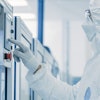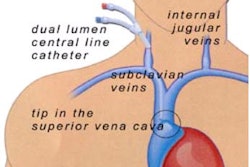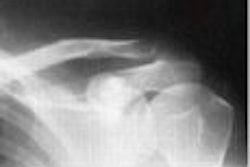LAS VEGAS - Nearly 80% of the 1.3 million breast biopsies performed in the U.S. each year to evaluate suspicious mammographic findings are benign, according to the FDA. But new adjunctive technologies could put a serious dent in that percentage by excluding benign disease more accurately, and identifying malignancies at higher rates than are available with current tests.
"The question you have to ask about any new technology is, how good is the negative predictive value?" said Dr. Yuri Parisky, director of breast imaging at the University of Southern California in Los Angeles. "This is a test that is going to take a woman out of a biopsy category and put her into a follow-up category. That (negative predictive value) has to be in the high (nineties) to 100%."
Parisky, speaking at the National Consortium of Breast Centers conference Monday, outlined new technologies ranging from electrical impedance scanning to optical imaging and infrared imaging systems. At least three vendors have products approaching commercialization and another 10 to 15 are in various stages of development, he said.
Spurred by the promise of existing physiological imaging modalities like PET, the new tools employ various technologies to detect energy consumption of abnormal breast tissue or malignancy-induced vascular changes such as angiogenesis.
Among current adjunctive tools such as ultrasound and MRI, there is much room for improvement, he said. PET, with a positive predictive value of 95% and an NPV of 75%, is a very promising adjunctive tool. A number of manufacturers are creating mini-PET systems that can be mounted on or correlated with mammograms in the same way that PET is being fused with CT in fusion imaging systems, Parisky said.
"But whether or not those findings are going to preclude a surgeon from sentinel node biopsy is doubtful," he said. "That’s why there has been so much interest in some of these other technologies."
DOBI takes a light approach
Dynamic optical breast imaging (DOBI) is one such tool, currently being tested in a multicenter clinical trial. A breast with a suspicious lesion is placed in a soft leather breast holder of the DOBI system. The breast is lightly compressed using a silicone "balloon." Light is then transmitted through the breast and recorded for up to 30 seconds. The image sequence is processed by proprietary software to accentuate differences in transmittance between normal and benign breast tissue.
Since cancer is associated with angiogenesis, interstitial fluid pressure is elevated around malignant tumors. The applied pressure induces different blood redistribution for benign versus malignant tissue. Changes in blood volume and oxygenation affect optical properties. A CCD camera detects light transmittance through the breast and shows the effect of absorption.
The most recent data, based on 88 patients scheduled for breast biopsy at New York Presbyterian Hospital and Hackensack University Medical Center in New Jersey, reported sensitivity of 86%, specificity of 73%, and an NPV of 94%.
"The images kind of resemble a moonscape, but I could learn to read them -- especially with reimbursement," Parisky said. "But the company (DOBI Medical Systems of Mahwah, NJ) is very early in its trial."
Computed laser tomography in trials
Another contender is computed laser tomography, developed by Imaging Diagnostic Systems in Plantation, FL. The device, in clinical trials at several sites across the U.S., uses a laser operating in the near-infrared portion of the electromagnetic spectrum. The laser light is transmitted into the breast, spurring differential reflection and refraction by normal and abnormal breast tissue.
Sensors detect the changes in photon energy as it passes through the breast. Algorithms process the raw data, and determine the signature appearance of either benign or malignant disease. The exam takes 15-20 minutes to perform, and uses no radiation or breast compression.
The company is farther along in its FDA submittal process than DOBI, Parisky said, but no data is available so far on specificity, NPV, or PPV.
TransScan's electrical impedance
Electrical impedance is another potentially promising technology. TransScan Medical of Ramsey, NJ, gained the first approval for an electrical impedance system in the 1990s, but the system has yet to achieve widespread acceptance, Parisky said. The technology measures the manner in which a small amount of electricity (one volt) travels through the breast. A map is created, and areas of abnormal conductivity identified.
A new company, Z-Tech of Toronto, is developing a system that uses a similar concept, called homologous electrical difference analysis (HEDA). Z-Tech exhibited at the 2002 RSNA conference and is in the process of submitting data to FDA, Parisky said.
Heat-seeking infrared cameras
Last but not least is thermal imaging. Using technology developed by Computerized Thermal Imaging of Lake Oswego, OR, Parisky participated in a multicenter trial and subsequent data submittal to the FDA.
The company’s BCS 2100 uses an infrared imaging camera to capture and record dynamic images of the breast and analyze more than 8 million temperature values to measure physiologic and metabolic changes in the tissue. In the clinical trial, the device correctly identified just 58 out of 322 benign breast masses, but demonstrated an NPV of 97%.
In December, however, the FDA’s Radiological Devices Advisory Panel voted against recommending device clearance for the time being, amid concerns that its use might delay needed treatment. The device was approved for use in Europe in 2002.
The regulatory blow to CTI is a good example of the kinds of challenges other emerging breast imaging technologies will likely face, Parisky said in his presentation.
"By essentially requiring adjunctive technologies to be near-perfect, the FDA is setting a high benchmark," he said. "Yet we all know that mammography misses 10%-15% of breast cancers. Ultrasound, MRI -- neither of those technologies has sensitivities that approach 100%."
A review of published literature outlining the positive and negative predictive values of current adjunctive technologies ranging from ultrasound to PET demonstrates that "this is an imperfect science," Parisky said. "But hopefully some of these new technologies will give us a physiological flavor for how the breast is behaving."
By Deborah R. DakinsAuntMinnie.com contributing writer
February 25, 2003
Related Reading
Start-up firm Photonify sees promise in optical imaging, January 14, 2003
Mammo plus US negates need for breast MR, December 23, 2002
Thermal breast-imaging device fails to win FDA advisors' support, December 11, 2002
Mammography screening controversy doesn’t dampen vendor efforts, December 1, 2002
MR spectroscopy of biopsy specimen could spare breast surgery
Breast gamma camera cleared by FDA, February 18, 2002
Copyright © 2003 AuntMinnie.com



















